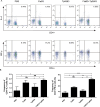Dual Immunization with Lipoprotein Tp0663 and Flagellin FlaB3 Offers Augmented Protection against Treponema pallidum in Mice
- PMID: 40321500
- PMCID: PMC12044484
- DOI: 10.1021/acsomega.5c00495
Dual Immunization with Lipoprotein Tp0663 and Flagellin FlaB3 Offers Augmented Protection against Treponema pallidum in Mice
Abstract
Syphilis is a significant multistage sexually transmitted infection caused by the bacterium Treponema pallidum. The pathogenesis of this pathogen remains inadequately understood, impeding the progress of syphilis vaccine development. Our prior study has demonstrated the potential of the Tp0663 protein as a viable candidate for a vaccine against T. pallidum. In the present study, we sought to explore the protective response of dual immunization using two different antigenic entities (i.e., flagellin FlaB3 and lipoprotein Tp0663) against T. pallidum in a murine model. Our investigation revealed that FlaB3 + Tp0663 can elicit robust humoral and cellular immune responses. In addition, the FlaB3 + Tp0663 vaccine demonstrated a notable reduction in the Treponemal burden within various anatomical sites of infected mice, including the blood, brain, liver, lymph nodes, spleen, and testicles. It is worth noting that the FlaB3 + Tp0663 vaccine suppressed the dissemination of T. pallidum in C57BL/6 mice. The findings demonstrate that T. pallidum flagellin FlaB3 may augment the immunoprotection of Tp0663. This represents a valuable practical perspective and offers insights into developing a syphilis vaccine.
© 2025 The Authors. Published by American Chemical Society.
Conflict of interest statement
The authors declare no competing financial interest.
Figures






Similar articles
-
Two Potential Syphilis Vaccine Candidates Inhibit Dissemination of Treponema pallidum.Front Immunol. 2021 Nov 25;12:759474. doi: 10.3389/fimmu.2021.759474. eCollection 2021. Front Immunol. 2021. PMID: 34899710 Free PMC article.
-
Immunogenicity and protective efficacy against Treponema pallidum in New Zealand rabbits immunized with plasmid DNA encoding flagellin.Emerg Microbes Infect. 2018 Nov 7;7(1):177. doi: 10.1038/s41426-018-0176-0. Emerg Microbes Infect. 2018. PMID: 30405111 Free PMC article.
-
Evaluation of FlaB1, FlaB2, FlaB3, and Tp0463 of Treponema pallidum for serodiagnosis of syphilis.Diagn Microbiol Infect Dis. 2016 Feb;84(2):105-11. doi: 10.1016/j.diagmicrobio.2015.10.005. Epub 2015 Oct 9. Diagn Microbiol Infect Dis. 2016. PMID: 26607421
-
Polypeptides of Treponema pallidum: progress toward understanding their structural, functional, and immunologic roles. Treponema Pallidum Polypeptide Research Group.Microbiol Rev. 1993 Sep;57(3):750-79. doi: 10.1128/mr.57.3.750-779.1993. Microbiol Rev. 1993. PMID: 8246847 Free PMC article. Review.
-
Notes on syphilis vaccine development.Front Immunol. 2022 Jul 28;13:952284. doi: 10.3389/fimmu.2022.952284. eCollection 2022. Front Immunol. 2022. PMID: 35967432 Free PMC article. Review.
References
-
- Korenromp E. L.; Rowley J.; Alonso M.; Mello M. B.; Wijesooriya N. S.; Mahiane S. G.; Ishikawa N.; Le L. V.; Newman-Owiredu M.; Nagelkerke N.; et al. Global burden of maternal and congenital syphilis and associated adverse birth outcomes-Estimates for 2016 and progress since 2012. PLoS One 2019, 14 (2), e021172010.1371/journal.pone.0211720. - DOI - PMC - PubMed
LinkOut - more resources
Full Text Sources
